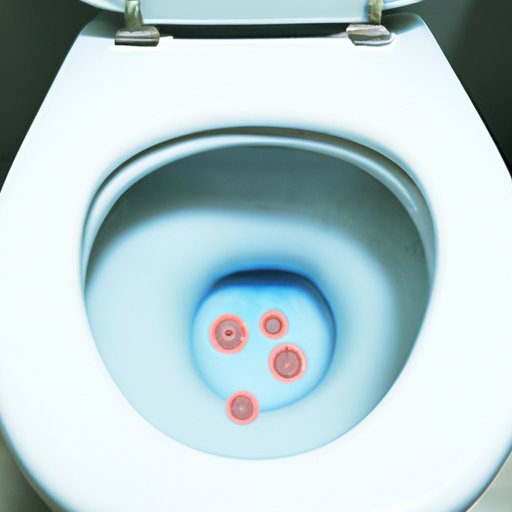
Introduction
Have you ever found yourself hesitating to use a public toilet seat, worried about the possibility of contracting a sexually transmitted disease (STD)? If so, you’re not alone. This common myth has many people wondering if toilet seats could be the source of transmitting STDs. In this article, we’ll explore the truth behind this myth and what you can do to stay protected in public restrooms.
Exploring the Myth: Can You Really Get STDs from a Toilet Seat?
For decades, people have believed that using public toilets could lead to STDs. The fear comes from the misconception that STDs can be spread through skin contact with contaminated surfaces, like toilet seats. The truth, however, is that toilet seats are unlikely to transmit STDs due to the way they are transmitted.
The myth about toilet seat transmission likely stems from misinformation. In the past, sexually transmitted infections (STIs) were often seen as a taboo topic, and people were taught to avoid any situation or activity that could lead to infection. This fear-based approach has fed into the myth even though it is not based on sound scientific evidence.
Of course, the fear of contracting an STD can be intense, and the thought of getting it from something as innocuous as a public toilet seat can trigger anxiety and discomfort. It’s critical to debunk the myth and provide accurate information to help people stay informed and reduce their fears.
The Science Behind STD Transmission and the Unlikeliness of Getting it from a Toilet Seat
STDs are typically transmitted through the exchange of bodily fluids. The fluids can include blood, semen, vaginal fluids, breast milk, or anal secretions. Skin-to-skin contact and unprotected sexual activity are the most common ways that STDs can be transferred. STDs can also be transmitted through shared needles or from mother to child during pregnancy or breastfeeding.
To understand why toilet seats can’t transmit STDs, we need to look at the conditions required for STD transmission to occur. As mentioned earlier, the transmission of STD requires contact with an infected person’s bodily fluids.
The virus or bacteria that causes the STD cannot survive outside the body for very long. After leaving the body, the virus is unable to replicate, which means that it will quickly die off. As such, it is highly unlikely for the virus to survive long enough on a toilet seat to pose a risk of transmission.
Debunked: The Truth About Whether or Not You Can Get an STD from a Public Toilet Seat
So, can you get an STD from a public toilet seat? The answer is no. There is no known case of anyone getting an STD from a public toilet seat. As we have already discussed, the conditions for transmission to occur are highly unlikely, given the limited lifespan of the viruses outside the human body.
However, it’s important to note that public restrooms can still be a source of bacterial infections or other diseases. For example, a bacteria that causes urinary tract infections (UTIs) can survive on surfaces for up to six days. Therefore, it is still vital for people to practice good hygiene to prevent the transfer of bacteria and viruses from public restrooms.
The Mixed Truths About STDs and Public Restrooms: Separating Facts from Fears
While it’s unlikely that toilet seats can transmit STDs, it is still possible to contract an STD or bacterial infection in a public restroom.
For example, touching contaminated surfaces such as faucets, toilet flush handles, or door handles can lead to the transfer of bacteria or viruses. Additionally, skin-to-skin contact can also lead to infection, although this is unlikely in public bathrooms. Therefore, it’s critical to practice good hygiene habits that can help prevent the spread of STDs and other infections.
To reduce the risk of infections from public toilets, avoid touching surfaces as much as possible, particularly in high-risk areas like door handles and faucets. Wash your hands thoroughly after using the restroom and use tissues or toilet paper to touch door handles after washing your hands.
How to Keep Yourself Protected from STDs in Public Restrooms: Expert Tips and Advice
It’s vital to take steps to protect yourself from STDs when using public restrooms. Here are some tips that can help you stay safe:
- Wash your hands thoroughly after using the restroom.
- Avoid touching surfaces as much as possible, particularly in high-risk areas like door handles and faucets.
- Use tissues or toilet paper to touch door handles after washing your hands.
- Practice safe sex, including using condoms and regular sexual health screenings.
Conclusion
In conclusion, toilet seats are an unlikely source of sexually transmitted infections or diseases. While it is essential to take action to prevent contracting an infection in a public restroom, the probability of contracting an STD from a toilet seat is negligible. It’s time to dismantle this myth and provide people with accurate health information to reduce anxiety and support healthy practices.
Remember, the best way to keep yourself and others safe is to practice good hygiene habits, use appropriate protection during sexual activity, and stay informed about your sexual health.





